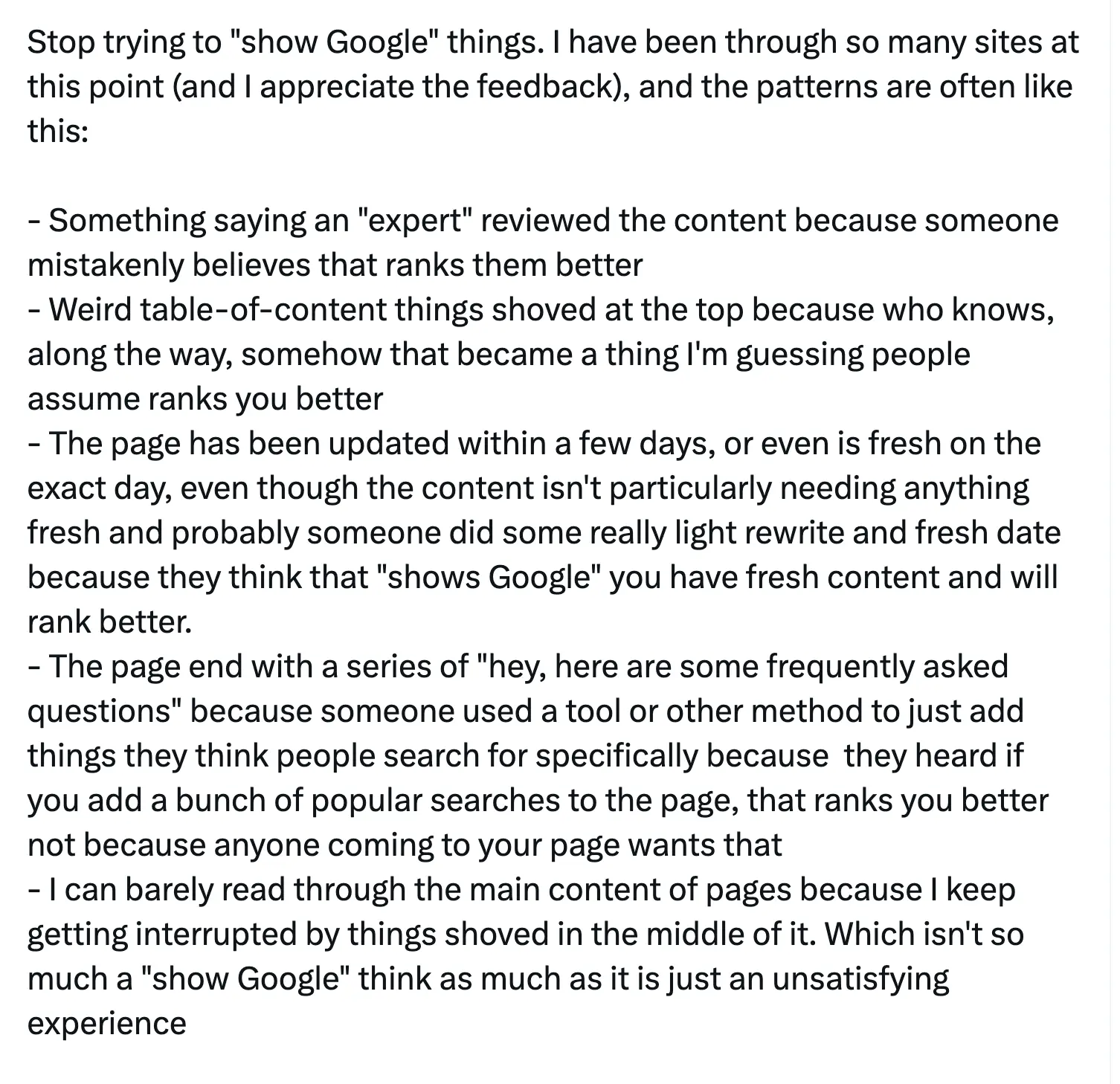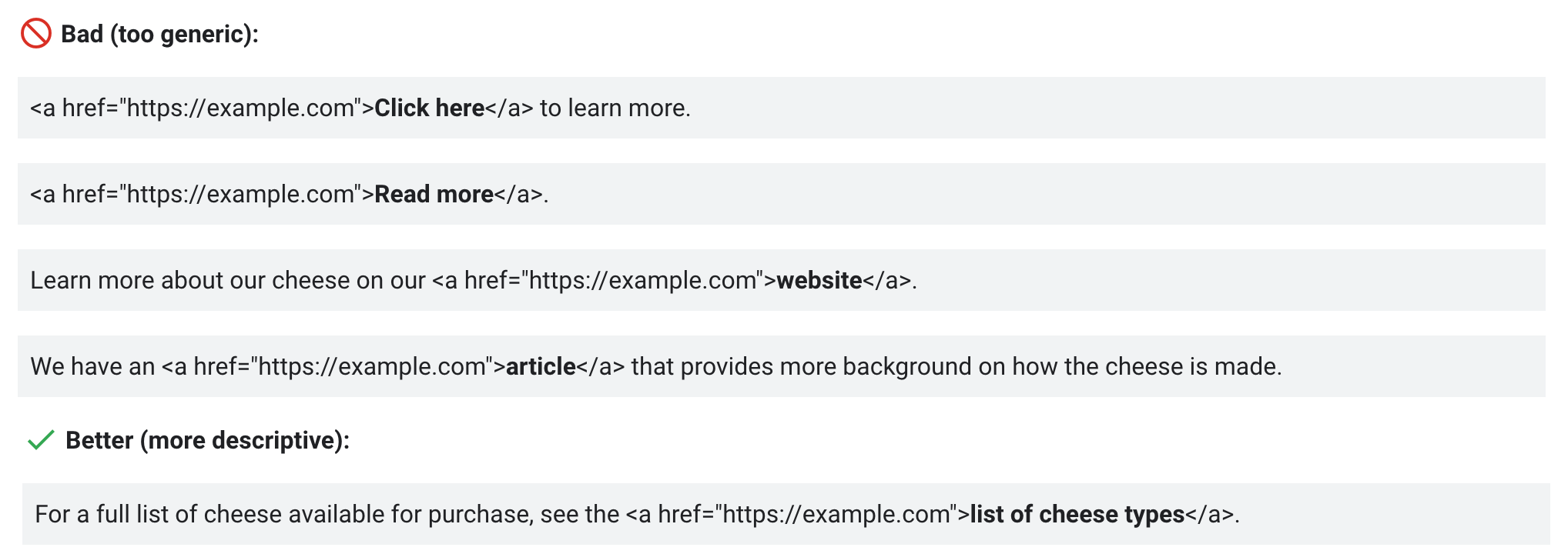Optimizing your content for search engines is a good practice. It helps people and bots understand your content better, but over-optimizing SEO can damage your rankings and domain reputation.
In this post, you'll learn what SEO over-optimization is and how to avoid it.
What Is SEO Over-Optimization?
For some, SEO over-optimization is the practice of making too many SEO improvements simultaneously. This raises red flags in Google that reduce a website's ranking ability. In reality, though, making many SEO changes simultaneously is not a problem.
The issue occurs when you engage in activities that violate Google guidelines, such as keyword stuffing and building over-optimized links.
Why Is Over-Optimizing Your Website Bad?
Search engines (especially Google) rank websites that offer helpful content to users, not SEO-optimized websites. A website focusing on the user experience will not repeat the same keywords repeatedly because it's good for SEO, but it will use natural language to engage with the audience.
Another example is artificially building links to manipulate search engine rankings or massively creating new content using AI tools to get more pages in the index without providing real value to your users.
Ranking algorithms are designed to recognize and penalize such behavior, which can result in lower rankings or even a complete ban from search results.
So, while working on your SEO, you should be careful not to cross the line and over-optimize your website. Use the following tips as your guide.
How to Avoid SEO Over-Optimization
- Avoid Keyword Stuffing
- Exact Match Backlinks
- Avoid Targeting Non-Relevant Keywords
- Do Things For Users, Not Search Engines
- Closely Monitor Your SEO Performance
1. Avoid Keyword Stuffing
Keyword stuffing is the practice of excessively using your target keywords (and closely related) in your content to manipulate a page's ranking in search engine results. This often leads to repetitive content that is unnatural and hard to read.
For example, if you're writing about "vegan recipes," keyword stuffing might look like this:
"Discover our vegan recipes for every meal! Our vegan recipes guide includes easy recipes, delicious plant-based cooking ideas, and healthy vegan meals for families."
The non-keyword stuffed version would be:
"Explore our collection of vegan recipes suitable for any meal! This guide offers simple, tasty options for plant-based cooking and nutritious meals perfect for the whole family."
When you get used to SEO writing, writing naturally is sometimes difficult. Even if you intend not to stuff keywords in your content, you may do so without realizing it.
The thing is, you don't have to. Search engines are intelligent enough to understand what a piece of content is about without using too many keywords.
Having your target keyword in the page title and H1 tag and a couple of related keywords in your page headings and content is all you need to do. Anything else can be considered over-optimization and should be avoided.
If you blindly follow the advice of SEO optimization tools and add all the possible variations of a keyword in your content, you may end up damaging your rankings.
Google doesn't like content that is fully optimized for search because it's unnatural. Natural writing will not include all keywords or phrases a machine looks for.
2. Exact Match Backlinks
Backlinks are good for SEO. They can help a website rank for specific keywords by signaling to search engines that the content is valuable and relevant.
However, when all your backlinks use the exact same keyword-rich anchor text, it appears manipulative and unnatural to search engines. This practice can lead to Google penalties and the loss of all your rankings, traffic, and, more importantly, Google trust.

Instead of focusing on exact match backlinks, aim to get links using varied anchor text. Include branded terms, natural phrases like "click here" or "learn more," and variations of your main keywords.
This variety makes your backlink profile appear more natural and trustworthy to search engines, enhancing your SEO efforts without risking over-optimization.
3. Avoid Targeting Non-Relevant Keywords
Many websites publish content around keywords (usually with a high search volume) irrelevant to the site's primary purpose. Depending on the domain authority, they may experience temporary rankings (and traffic), but in the long run, Google Helpful Content Update will likely penalize them.
This update penalizes websites publishing content solely for SEO and promotes websites that genuinely satisfy user intent and provide value.
To avoid this pitfall, focus on creating content that aligns with your niche and meets the needs of your audience. Choose keywords relevant to your products, services, and industry, ensuring that each piece of content serves a purpose and enhances the user experience.
Think about what your website should be known for and publish content that works towards that goal.
4. Do Things For Users, Not Search Engines
When trying to improve your SEO, you may do things that seem to work for other websites, not because they are good for your users but because you're under the impression that Google likes them.
Google Search Liaison shared some examples on X (Twitter) of SEO practices that have become trending without considering the user experience.

Here are a few examples:
- Adding a weird table of contents on top of the content.
- Adding FAQ sections on pages that are not really needed.
- Changing the publication date of a post without making significant changes to the content just to show Google that the page is updated.
- Adding a shopping cart to your website to trick Google that you're an actual business and not an affiliate website.
The bottom line is that Google has become intelligent enough to differentiate between SEO tricks and real valuable content. As mentioned by Google Search Liaison:
If you want to succeed, stop doing a lot of the things you've heard second, third, whatever that are supposed to "show Google" something and show your visitors a great, satisfying experience.
So, to avoid SEO over-optimization, whenever you make a change on your website, always consider the users' experience and how to improve it, and not because it's good for SEO.
SEO is simpler than you think and can be summarized into the following:
- Publish original content to satisfy the user's search intent.
- Create fast websites with a good site structure.
- Solve any technical SEO issues.
- Promote your website using white-hat off-page SEO practices (like digital PR).
If you consistently do the above, your rankings and traffic will increase without you having to worry about breaking any SEO rules.
5. Closely Monitor Your SEO Performance
Closely monitoring your SEO performance is essential in identifying and avoiding over-optimization issues. By monitoring keyword rankings, organic traffic, bounce rates, and engagement rates, you can determine whether your SEO strategies benefit or harm your website.
Keep an eye on Google's algorithmic changes and guidelines and follow their advice. Compare your traffic and rankings every time there is a Google update, and look for any sudden drops or gains in rankings or traffic.
If you're negatively affected, it could be because you did more for SEO than expected. To recover, you may need to review and update your content and practices to comply with Google guidelines.
What Is Not SEO Over-Optimization?
While doing my research for writing this post, I came across some advice that is wrong, which Google does not consider to be an SEO over-optimization. You should be aware of:
1. Keyword-Rich Anchor Text For Internal Links
Internal links are helpful for users and search engines, and unlike backlinks and external links, there is no penalty for using keyword-rich anchor text.
Google's Jonh Mueller recently confirmed that using optimized anchor text for your internal links is not a problem; on the contrary, it is recommended. Keywords in anchor text help Google and users understand what the page is about, and when used wisely, they can help your SEO in many ways.

2. Having More Than One H1 Tag On The Page
While it's not a best SEO practice, having more than one H1 tag on your page is not considered SEO over-optimization. It's better to have only one, but if that's not the case, Google will not penalize you for this.
In a recent update of the SEO Started Guide, Google mentions that you should not give too much attention to the number and order of headings. In particular, they mentioned:
Having your headings in semantic order is fantastic for screen readers, but from Google Search perspective, it doesn't matter if you're using them out of order. There's also no magical, ideal amount of headings a given page should have.
3. Optimizing Core Web Vitals Metrics
Optimizing your website for speed and core web vitals is not bad. Google says it's not an important ranking factor, and you should not be obsessed with it, but that does not mean you should not work on getting the best possible scores.
Fast websites are good for users, and it's worth allocating time and money to get your core web vital scores to the desired levels. You won't have to deal with it again once you fix any issues and follow best practices like optimizing your images, using a caching plugin, etc.
Conclusion: Don't Over Optimize Your Website
The key takeaway from this post is that you shouldn't over-optimize your website for Google. Instead, you should build a website that serves a particular purpose and follows practices contributing to a positive user experience.
Regular analysis of your SEO performance allows you to spot potential issues and be proactive about adhering to Google guidelines. Writing naturally for users and creating content relevant to your website goals without engaging in shady link-building practices will guarantee long-term SEO success.



